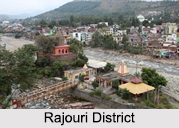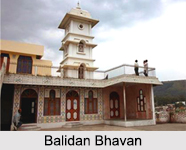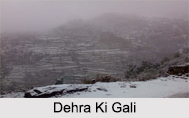 Rajouri District is a district of Jammu region in Indian state of Jammu and Kashmir which had been part of Poonch district prior to 1967. It is famous for its "kalari" (kind of cheese) and has six tehsils. The District has an area of 2630 square kilometres with peculiar physical features. Maize, wheat and rice are the main crops of the area and the main source of the irrigation is the river Tawi that originates from the mountains of Pir Panjal.
Rajouri District is a district of Jammu region in Indian state of Jammu and Kashmir which had been part of Poonch district prior to 1967. It is famous for its "kalari" (kind of cheese) and has six tehsils. The District has an area of 2630 square kilometres with peculiar physical features. Maize, wheat and rice are the main crops of the area and the main source of the irrigation is the river Tawi that originates from the mountains of Pir Panjal.
History of Rajouri District
Rajouri district has a great historical significance. In the Mahabharata, there was a kingdom known as Panchal Desa. Rajouri was a part of this kingdom of Panchal Naresh. Rajouri, then known as Rajapuri - `the land of Kings` - finds its mention in the travelogue of Chinese traveller Hiuen Tsang who visited the town in 632 A.D. and described it as a part of Kashmiri dominion. Still earlier in the Buddhist period it formed a part of Gandhar territory. At the time of Alexander`s invasion, Rajouri was at the height of its glory. In Mauryan period, the town of Rajouri was a great trade centre. During the Mughal rule, the rulers of Rajouri have embraced Islam though they retained the title of Raja. On 22nd September 1967, Government divided district Poonch into two districts namely `Rajouri` and `Poonch`, to facilitate the process of development and better supervision of economic activities in this area. By this way, Rajouri emerged as a District from 1st January 1968.
 Geography of Rajouri District
Geography of Rajouri District
The District has an area of 2630 square kilometres with peculiar physical features. District Rajouri is 154 kilometres away from Winter Capital Jammu. It is located in the foothills of Pir Panjal Range. The Districts Udhampur and Jammu surround the District in the East, Line of actual control passes on the Southern side, on the West it is bounded by Poonch District and Pulwama District is on the North. The climate of the region varies from semitropical in the Southern part comprising Nowshera, Sunderbani and Kalakote to temperate in the mountainous Northern part comprising the area of Rajouri, Thannamandi and Koteranka Tehsils of the District. The average rainfall recorded here is 500 mm and average temperature varies from 7.42 degree Celsius to 37.4 degree Celsius.
Demography of Rajouri District
According to the 2011 census, Rajouri district has a population of 642,415. The district has a population density of 235 inhabitants per square kilometre. Rajouri has a sex ratio of 863 females for every 1000 males and a literacy rate of 68.54 percent. The religious distribution, in accord with the 2011 census, was 402,879 Muslim (62.7154percent), 221,880 Hindu (34.5454percent), 2.4154percent Sikhs and others.
Urdu and English are the main mediums of instruction and the main native languages are Pahari and Gujari. Pahari is mainly spoken by the Malik community that forms majority of Darhal Malkan. Gujari is primarily spoken by the Gujjar and Bakarwal which add much Muslim population of Rajouri.
Administration of Rajouri District
The district is divided into seven Tehsils and seven blocks. Rajouri District comprises of 379 villages (375 are inhabited villages) out of which Hindu population dominates 157 villages while Muslim dominates 228 villages and Sikh population dominates 2 villages. This district consists of nine blocks: Rajouri, Doonji, Nowshera, Darhal, Manjakote, Thanamandi, Sunderbani, Kalakote, and Budhal. Each block consists of a number of panchayats.
 Education of Rajouri District
Education of Rajouri District
Rajouri District has a literacy rate of 57.65 percent. There are 719 primary schools and 18 higher secondary and 82 secondary schools in the district. There are three colleges in this district of Jammu and Kashmir. The government has done a lot for Gujjars and Bakerwals in the matter of education by way of permanent and mobile schools, starting of Gujjar and Bakerwals hostels at the District level with free boarding and lodging facilities up to 12th class and reservation in employment and vocational institutions.
Culture of Rajouri District
Culture is an integral part of the people of Rajouri District. The people devote their time to handicraft activities, so as to supplement their small incomes. Due to the diversity of handicrafts, it can be said mini Kashmir. Embroidery, Chikri-wood carving, Tilla (Copper) work, Namda and Gabba making, basket making, Blanket making, etc. are the most important handicrafts of the districts. The life of the people of Rajouri is a mix of Dogri, Gujari, Poonchi, Pahari, and Kashmiri culture. Folk songs and folk dances of a particular region illustrate the living style of people, their tastes, rituals, traditions, costumes, and culture. Different cultural forms and styles of singing and dances are still widespread in the region. Folk forms have remained the favourites of the masses. Festivals, marriages, fairs, and other rituals, each have a style to suit the occasion.
Tourism in Rajouri District
Rajouri district has several charming tourist spots. Places worth seeing near Rajouri town are Rajouri fort, Balidan Bhavan, Gurudwara Chhati Padshahi, Rama Temple, Jama Masjid and Shiv Mandir. Dehra Ki Gali is a stunning picturesque spot situated at a height of over 6600 feet above sea level, in the Pir Panjal Range and is one of the passes which connect Rajouri and Poonch districts. Thick vegetation cover attracts and charms the tourist. Thanna Mandi is a significant historical place right from the time of Mughals, who used to stay there during their journey from Delhi to Kashmir and vice-versa. An old Mughal Sarai still exists there which speaks of its glorious time. Kotranka Budhal is an eye-catching tourist spot. During summer this spot affords a great attraction to the nature lovers and tourists. This is a scenic charming and peaceful spot to retire to in the summer heat.
Visiting Information of Rajouri District
Rajouri district is situated 154 kilometres away from Jammu, the winter capital of Jammu and Kashmir. The only means to reach Rajouri is through Road. Buses, Video Coaches and shared taxis are plying on the road on regular basis throughout the day from the Jammu Bus Stand.






